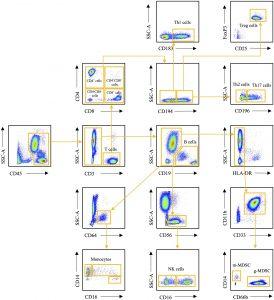A recent study investigated the impact of exercise on immune cell function in breast cancer patients. The findings suggest that even a single 30-minute exercise session can significantly alter the composition of circulating white blood cells, potentially favouring an anti-tumour immune response (Figure 1).
White blood cells, also known as leukocytes, are the body’s primary defence against pathogens and cancer. However, their role in cancer is complex. Certain white blood cell subtypes, like cytotoxic T lymphocytes (CTLs) and natural killer (NK) cells, directly target and eliminate cancer cells. Conversely, other subtypes, such as regulatory T cells (Tregs) and myeloid-derived suppressor cells (MDSCs), can suppress immune responses and even promote tumour growth.
The study involved 20 women with newly diagnosed breast cancer who had not yet begun treatment. Blood samples were collected before, during, and after a 30-minute cycling session on a stationary bike. The researchers then analysed the number and proportions of various white blood cell types.
The results revealed a notable increase in several white blood cell populations following exercise. Importantly, the number of CTLs and NK cells, the body’s arsenal against cancer, showed the most significant rise. In contrast, the levels of Tregs and MDSCs, which can impede anti-tumour immunity, remained unchanged or even decreased slightly.
Furthermore, the study examined the relative proportions of different white blood cells within the total leukocyte count. This analysis demonstrated a significant increase in the percentage of NK cells, while the proportion of MDSCs decreased. These findings suggest a potential shift towards an immune state more conducive to cancer eradication.
However, the researchers acknowledge that it remains unclear whether these changes in circulating white blood cells translate to similar alterations within the tumour microenvironment, the immediate surroundings of the cancer cells. Additionally, the study observed that the elevated white blood cell levels returned to baseline within an hour after exercise. While the destination of these cells after exercise is unknown, preclinical studies suggest that exercise can promote the migration of anti-tumour immune cells towards tumour sites.
The study also explored potential variations in exercise-induced immune responses based on tumour characteristics. The findings suggest that larger tumours might be associated with a less pronounced increase in NK cells. Additionally, tumours positive for oestrogen and/or progesterone receptors exhibited a smaller rise in CTLs compared to receptor-negative tumours.
This study adds to the growing body of evidence highlighting the potential of exercise as a complementary strategy to enhance the body’s natural defences against cancer.
Journal article: Koivula, T., et al., 2024. The effect of exercise and disease status on mobilization of anti-tumorigenic and pro-tumorigenic immune cells in women with breast cancer. Frontiers in Immunology.
Summary by Stefan Botha











